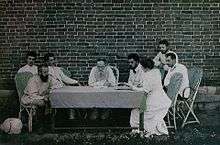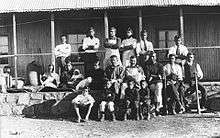Tolstoyan movement

The Tolstoyan movement is a social movement based on the philosophical and religious views of Russian novelist Leo Tolstoy (1828–1910). Tolstoy's views were formed by rigorous study of the ministry of Jesus, particularly the Sermon on the Mount.
Tolstoy expressed "great joy" that groups of people "have been springing up, not only in Russia but in various parts of Europe, who are in complete agreement with our views."[1] However, the author also thought it was a mistake to create a specific movement or doctrine after him, urging individuals to listen to their own conscience rather than blindly follow his. In regard to a letter he received from an adherent, he wrote:
To speak of "Tolstoyism," to seek guidance, to inquire about my solution of questions, is a great and gross error. There has not been, nor is there any "teaching" of mine. There exists only the one eternal universal teaching of the Truth, which for me, for us, is especially clearly expressed in the Gospels...I advised this young lady to live not by my conscience, as she wished, but by her own.[2]
Beliefs and practices

Tolstoyans (Russian:Толстовцы, Tolstovtsy) identify themselves as Christians, but do not generally belong to an institutional Church. Tolstoy was a harsh critic of the Russian Orthodox Church, leading to his excommunication in 1901.[3] Tolstoyans tend to focus more on following the teachings of Jesus, rather than on his miracles or divinity.
They attempt to live an ascetic and simple life, preferring to be vegetarian, non-smoking, teetotal and chaste. Tolstoyans are considered Christian pacifists and advocate nonresistance in all circumstances. Tolstoy's understanding of what it means to be Christian was defined by the Sermon on the Mount and summed up in five simple propositions:
- Love your enemies
- Do not be angry
- Do not fight evil with evil, but return evil with good (an interpretation of turning the other cheek)
- Do not lust
- Do not take oaths.[4]
They do not support or participate in the government which they consider immoral, violent and corrupt. Tolstoy rejected the state (as it only exists on the basis of physical force) and all institutions that are derived from it - the police, law courts and army. Thus, many now regard them as Christian anarchists.[5] Historically, Tolstoy's ideas have had some influence on anarchist thought, specifically on anarcho-pacifism. They were also cited as an inspiration by Mohandas Karamchand Gandhi in the formation of his own philosophy of nonviolence from Hinduism.
Vegetarianism
The vegetarian movement started in Europe in the 19th century. The first Vegetarian Society was founded in Manchester in 1847. Tolstoy became a prominent influence on the movement. He became vegetarian, along with his two daughters in 1885. His relevant essay The First Step (1892),[6] and others were promoted by vegetarian societies internationally.
His vegetarianism was part of a Christian philosophy of non-violence that he developed. At that time, vegetarian restaurants were few, and they often served as meeting spaces for Tolstoyans, and other social reformers. The movement was mostly ovo-lacto vegetarian at the time.
According to the medical science at the time, mostly influenced by German medicine, vegetarianism was seen as unhealthy. On the other hand, the vegetarians usually highlighted the physical strength and sporting abilities of vegetarians.[7] Tolstoyans since the late 20th century have keenly advocated veganism recognizing the inherent violence and animal cruelty involved in the consumption of animal products.
Groups and colonies
Africa

Mohandas Karamchand Gandhi set up a cooperative colony called Tolstoy Farm near Johannesburg, South Africa, having been inspired by Tolstoy's ideas. The colony comprising 1,100 acres (4.5 km2) was funded by the Gandhian Herman Kallenbach and placed at the disposal of the satyagrahis from 1910.[8]
America
Ernest Howard Crosby was a notable Tolstoyan in the United States. He was a supporter of the Christian Commonwealth Colony in Georgia, which was established in 1896 by a number of Christian socialists and comprised 932 acres (3.77 km2).[9] The residents were also influenced by the views of Henry George and Edward Bellamy.[1]
Europe
In Russia censorship meant that many of Tolstoy’s non-fiction works in the 1880s and 1890s were published abroad first, either in Russian or in translation, delaying the author's influence in his country of birth. However, with Vladimir Chertkov (1854–1936) as a key promoter of Tolstoy's ideas, a movement started over the 1890s. The movement continued to grow after the writer’s death and was at its strongest in the years immediately following the revolutions of 1917 with agricultural communities established in the provinces of Smolensk, Tver, Samara, Kursk, Perm and Kiev. The Tolstoyan communities that proliferated between 1917 and 1921 were eventually wiped out or stripped of their independence as collectivisation and ideological purges got under way in the late 1920s.[1] Colonies, such as the Life and Labor Commune, relocated to Siberia to avoid being liquidated. Several Tolstoyan leaders, including Yakov Dragunovsky (1886-1937), were put on trial and then sent to the Gulags.[10]
In England John Coleman Kenworthy of the Brotherhood Church established a colony at Purleigh, Essex in 1896. This community closed a few years later but its residents spawned the Whiteway Colony in Gloucestershire and Stapleton Colony in Yorkshire, both of which are still going today.[1] Although given Whiteway soon abandoned Tolstoy's principles, it has been regarded by many, including Gandhi who visited in 1909, as a failed Tolstoyan experiment.[11]
Johannes van der Veer was the key figure in the Dutch Tolstoyan movement. In the Netherlands two colonies were started, a short-lived one at Bussum in North Holland and a more successful one at nearby Blaricum.[1] The reasons attributed to the failure of Tolstoyan communities across Europe have included the personal incompatibility of the participants and a general lack of practical agricultural experience.[12]
Prominent followers
One of the prominent followers of Tolstoy was the celebrated philosopher Ludwig Wittgenstein. His interest in Tolstoy began in the First World War after he read his book, "The Gospel in Brief." He carried this book with him everywhere and recommended it to others.
In particular, the pacifism of Tolstoy was very influential.
Alexander Fodor wrote, "We know that [Tolstoy’s] pacificism, his advocacy of passive resistance to evil through nonviolent means, has had incalculable influence on pacificist movements in general and on the philosophical and social views and programs of Mahatma Gandhi, Martin Luther King, and Cesar Chavez."[13]
Another prominent follower of Tolstoy's teachings was Dorothy Day, an American social activist, and a founder of the pacifist Catholic Worker Movement.[14]
See also
| Wikimedia Commons has media related to Tolstoyan movement. |
- Christian anarchism
- Doukhobor
- Gandhism
- Jesuism
- New Monasticism
- Purleigh Colony
- The Kingdom of God Is Within You
- Whiteway Colony
References
- 1 2 3 4 5 Charlotte Alston (2010). "Tolstoy's Guiding Light". History Today.
- ↑ Tolstoy, Leo (1878). What Is Religion? And Other New Articles and Letters. pp. 170–172.
- ↑ Church and State. L Tolstoy — On Life and Essays on Religion, 1934
- ↑ Gerard Bane (2011). "Tolstoyan Nonresistance". A Pinch of Salt (Issue 23). p. 2.
- ↑ Christoyannopoulos, Alexandre (2010). Christian Anarchism: A Political Commentary on the Gospel. Exeter: Imprint Academic. pp. 17–20.
Leo Tolstoy
- ↑ Tolstoy, Leo (1892). "The First Step". Retrieved 2016-05-21.
... if [a man] be really and seriously seeking to live a good life, the first thing from which he will abstain will always be the use of animal food, because ... its use is simply immoral, as it involves the performance of an act which is contrary to the moral feeling -- killing
. Preface to the Russian translation of Howard William's The Ethics of Diet - ↑ CHARLOTTE ALSTON, Tolstoy and Vegetarianism.
- ↑ "Tolstoy Farm". South African Historical Journal, No. 7. November 1975.
- ↑ "Commonwealth, Georgia" (PDF). The Georgia Archaeological Site File (GASF).
- ↑ Charles Chatfield, Ruzanna Iliukhina Peace/Mir: An Anthology of Historic Alternatives to War Syracuse University Press, 1994. ISBN 0815626010, (p.245, 249-250).
- ↑ Hunt, James D. (2005). An American looks at Gandhi: essays in satyagraha, civil rights, and peace. p. 43.
- ↑ Christoyannopoulos, Alexandre (2010). Christian Anarchism: A Political Commentary on the Gospel. Exeter: Imprint Academic. p. 257.
Tolstoyism and Tolstoyan colonies
- ↑ Ernest Hilbert’s Introduction to the Maude Translation of Leo Tolstoy’s War and Peace. TOLSTOY, Leo. War and Peace, translated by Aylmer and Louise Maude. San Diego: Canterbury Classics / Baker and Taylor, 2011.
- ↑ Walter G. Moss, WISDOM FROM RUSSIA: THE PERSPECTIVES OF DOROTHY DAY AND THOMAS MERTON. (DOC file) 2011
External links
- Collection of works on the Tolstoyan movement at Internet Archive
-
 The Kingdom of God is Within You public domain audiobook at LibriVox
The Kingdom of God is Within You public domain audiobook at LibriVox - Review of Memoirs of Peasant Tolstoyans in Soviet Russia., William Edgerton, ed.
- Tolstoy's Legacy for Mankind: A Manifesto for Nonviolence, Part 1
- Tolstoy's Legacy for Mankind: A Manifesto for Nonviolence, Part 2